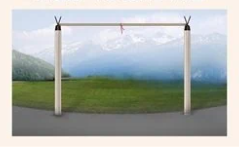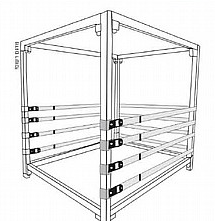So, recently I've been reading Yonatan Grossman's excellent book on biblical style "גלוי ומוצפן: על כמה מדרכי העיצוב של הסיפור המקראי". The first couple chapters deal with many various types of word choice and word play. For this post, I'd like to highlight a wordplay I noticed recently in Megilat Esther between the words כן and חן, which together form a
Leitwort Pair for the book of Esther. This wordplay directly connects to one of the Megila's major themes, that of the conflict between Human Kingship and God's Kingship amidst Exilic existence.
The Law
The word כן appears 13 times in 11 verses in the Megilla, always associated with Persian Law and Royal Decrees. This includes the laws of Ahasuerus' feast, the contest rules for a new Queen, Vashti and Haman's judgements, and Esther's commands to the Jews to fast and to celebrate.
- אסתר א8: והשתיה כדת אין אנס כי כן יסד המלך על כל רב ביתו לעשות כרצון איש ואיש
- אסתר א13: ויאמר המלך לחכמים ידעי העתים כי כן דבר המלך לפני כל ידעי דת ודין
- אסתר ב4: והנערה אשר תיטב בעיני המלך תמלך תחת ושתי וייטב הדבר בעיני המלך ויעש כן
- אסתר ב12: ובהגיע תר נערה ונערה לבוא אל המלך אחשורוש מקץ היות לה כדת הנשים שנים עשר חדש כי כן ימלאו ימי מרוקיהן ששה חדשים בשמן המר וששה חדשים בבשמים ובתמרוקי הנשים
- אסתר ג2: וכל עבדי המלך אשר בשער המלך כרעים ומשתחוים להמן כי כן צוה לו המלך ומרדכי לא יכרע ולא ישתחוה
- אסתר ד16: לך כנוס את כל היהודים הנמצאים בשושן וצומו עלי ואל תאכלו ואל תשתו שלשת ימים לילה ויום גם אני ונערתי אצום כן ובכן אבוא אל המלך אשר לא כדת וכאשר אבדתי אבדתי
- אסתר ו10: ויאמר המלך להמן מהר קח את הלבוש ואת הסוס כאשר דברת ועשה כן למרדכי היהודי היושב בשער המלך אל תפל דבר מכל אשר דברת
- אסתר ז5: ויאמר המלך אחשורוש ויאמר לאסתר המלכה מי הוא זה ואי זה הוא אשר מלאו לבו לעשות כן
- אסתר ט14: ויאמר המלך להעשות כן ותנתן דת בשושן ואת עשרת בני המן תלו
- אסתר ט19: על כן היהודים הפרוזים הישבים בערי הפרזות עשים את יום ארבעה עשר לחדש אדר שמחה ומשתה ויום טוב ומשלוח מנות איש לרעהו
- אסתר ט26: על כן קראו לימים האלה פורים על שם הפור על כן על כל דברי האגרת הזאת ומה ראו על ככה ומה הגיע אליהם
But is this a Leitwort? On the one hand, a Leitwort needs to be a word that catches the ear of the reader. So, the word כן cannot have this distinction because it is such a simple, common word in Tanach. But what if it relates to another word?
Esther's Charm
The Megilla's use of the word כן becomes a wordplay with the introduction of Esther and her influence on Ahasuerus' court. Esther time and again approaches the challenges of Persian Law and overcomes them. She does this with the attribute of charm(חן). This חן of Esther overcomes the כן of Persian law six times throughout Megillat Esther, hence the wordplay between two similarly sounding words.
- אסתר ב15: ובהגיע תר אסתר בת אביחיל דד מרדכי אשר לקח לו לבת לבוא אל המלך לא בקשה דבר כי אם את אשר יאמר הגי סריס המלך שמר הנשים ותהי אסתר נשאת חן בעיני כל ראיה
- אסתר ב17: ויאהב המלך את אסתר מכל הנשים ותשא חן וחסד לפניו מכל הבתולות וישם כתר מלכות בראשה וימליכה תחת ושתי
- אסתר ה2: ויהי כראות המלך את אסתר המלכה עמדת בחצר נשאה חן בעיניו ויושט המלך לאסתר את שרביט הזהאשר בידו ותקרב אסתר ותגע בראש השרביט
- אסתר ה8: אם מצאתי חן בעיני המלך ואם על המלך טוב לתת את שאלתי ולעשות את בקשתי יבוא המלך והמן אל המשתה אשר אעשה להם ומחר אעשה כדבר המלך
- אסתר ז3: ותען אסתר המלכה ותאמר אם מצאתי חן בעיניך המלך ואם על המלך טוב תנתן לי נפשי בשאלתי ועמי בבקשתי
- אסתר ח5: ותאמר אם על המלך טוב ואם מצאתי חן לפניו וכשר הדבר לפני המלך וטובה אני בעיניו יכתב להשיב את הספרים מחשבת המן בן המדתא האגגי אשר כתב לאבד את היהודים אשר בכל מדינות המלך
The two repeated words with similar sounds כן-חן, form what Grossman calls an Leitwort Pair(צמד מילים מנחות). This is simply a Leitwort between the two related words like שמש-ירח or טוב-רע (see p.146). In our case the words are related phonetically, but they are also thematic opposites of sorts.
The point of the כן-חן wordplay is to highlight the conflict between the two central authorities in Esther. On the one hand we have Man's Kingship, the lone apparent superpower in the story. The King's commands are law for all to obey. On the other hand, we have God's kingship. The Jews are in exile, God's temple in ruins, yet even under these circumstances, God's influence ultimately overcomes Man's. It does so through more subtle means, symbolized by the softer, Feminine power of Esther. Thus the כן-חן wordplay emphasizes and sharpens the Man vs. God theme of the Megilla.
 |
| Esther accusing Haman, Ernest Norman, oil on canvas, 1888 |
Begging
But this particular wordplay does not stop there. Twice the text mentions Esther begging on behalf of her people, and again the ח-נ root is employed:
- אסתר ד8: ואת פתשגן כתב הדת אשר נתן בשושן להשמידם נתן לו להראות את אסתר ולהגיד לה ולצוות עליה לבוא אל המלך להתחנן לו ולבקש מלפניו על עמה
- אסתר ח3: ותוסף אסתר ותדבר לפני המלך ותפל לפני רגליו ותבך ותתחנן לו להעביר את רעת המן האגגי ואת מחשבתו אשר חשב על היהודים
Compare this with Haman's begging for his life then the ב-ק-ש root is instead used:
- אסתר ז7: והמלך קם בחמתו ממשתה היין אל גנת הביתן והמן עמד לבקש על נפשו מאסתר המלכה כי ראה כי כלתה אליו הרעה מאת המלך
Esther's influence reaches it's climax when she abandons subtlety and explicitly asks the King for mercy for her people. This more direct expression of Esther's influence is also an expression of God's Kingship in the world, as hinted at by the employment of the common root.
Names
One final piece in this puzzle is encoded within the names of incidental characters. In the names of the King's chief advisor Memuchan and the Judean King Yechonya associated with Mordechai, mentioned at the start of the Megilla, we again see the syllable כן employed.
- אסתר א14: והקרב אליו כרשנא שתר אדמתא תרשיש מרס מרסנא ממוכן שבעת שרי פרס ומדי ראי פני המלך הישבים ראשנה במלכות
- אסתר א16: ויאמר מומכן לפני המלך והשרים לא על המלך לבדו עותה ושתי המלכה כי על כל השרים ועל כל העמים אשר בכל מדינות המלך אחשורוש
- אסתר א21: וייטב הדבר בעיני המלך והשרים ויעש המלך כדבר ממוכן
- אסתר ב6: אשר הגלה מירושלים עם הגלה אשר הגלתה עם יכניה מלך יהודה אשר הגלה נבוכדנצר מלך בבל
Yechonya is spelled various ways in the Tanach:
- יהויכין
- יויכין
- יכוניה
- יכניה
Megilat Esther chooses the last spelling because it best fits with the כן-חן wordplay. The purpose of citing Yechonya and Memuchan at the beginning of Esther is to set up the two sides of the conflict. On one hand, the Persian Advisor Memuchan represents the Kingship of Man, on the other hand Mordechai, an exile of Yechonya, represents the Kingship of God which is in exile. The conflict between these two sides forms the basis for the action of the story.
Similarly, at the climax of the Megilla, another Persian councilor appears, to seal the fate of Haman. Harvona has the letters ח and נ embedded in his name, again emphasizing the triumph of the character trait of חן.
- אסתר ז9: ויאמר חרבונה אחד מן הסריסים לפני המלך גם הנה העץ אשר עשה המן למרדכי אשר דבר טוב על המלך עמד בבית המן גבה חמשים אמה ויאמר המלך תלהו עליו
Esther, Daniel, Yosef
Now let's connect this back to
our previous look at the parallels between Esther and two other Biblical stories, those of Yosef and Daniel.
It's worth noting that the root ח-נ also figures prominently in the story of Yosef, and in much the same context:
- בראשית לט4: וימצא יוסף חן בעיניו וישרת אתו ויפקדהו על ביתו וכל יש לו נתן בידו
- בראשית לט21: ויהי ה' את יוסף ויט אליו חסד ויתן חנו בעיני שר בית הסהר
- בראשית מב21: ויאמרו איש אל אחיו אבל אשמים אנחנו על אחינו אשר ראינו צרת נפשו בהתחננו אלינו ולא שמענו על כן באה אלינו הצרה הזאת
- בראשית נ4: ויעברו ימי בכיתו וידבר יוסף אל בית פרעה לאמר אם נא מצאתי חן בעיניכם דברו נא באזני פרעה לאמר
Sefer Daniel seems to favor a different word choice. Consider, for instance this line, which could have used the term למצא חן:
- דניאל א9: ויתן האלהים את דניאל לחסד ולרחמים לפני שר הסריסים
That said, there is a thematic parallel in that both Daniel and Esther include the challenges of surmounting a
strict legal system whose laws cannot be revoked or overridden. But what is interesting is how these two heroes differ in how they overcome their challenges: in Daniel, the laws are overcome through dream visions and miracles, while in Esther they are overcome through charm and political means. In this way Megillat Esther revises Daniel's message of how the Jewish People can survive in Exile. While Daniel charts a path of uncompromising piety and reliance on divine intervention, Esther shows how a more flexible approach can actually be an expression of God's kingship, rather than an affront to it.
Links
On a final note, I used Erel Segal-Halevi's
Tanach Search Engine in preparing this topic, so a big thanks to him for providing this resource to the public.


















